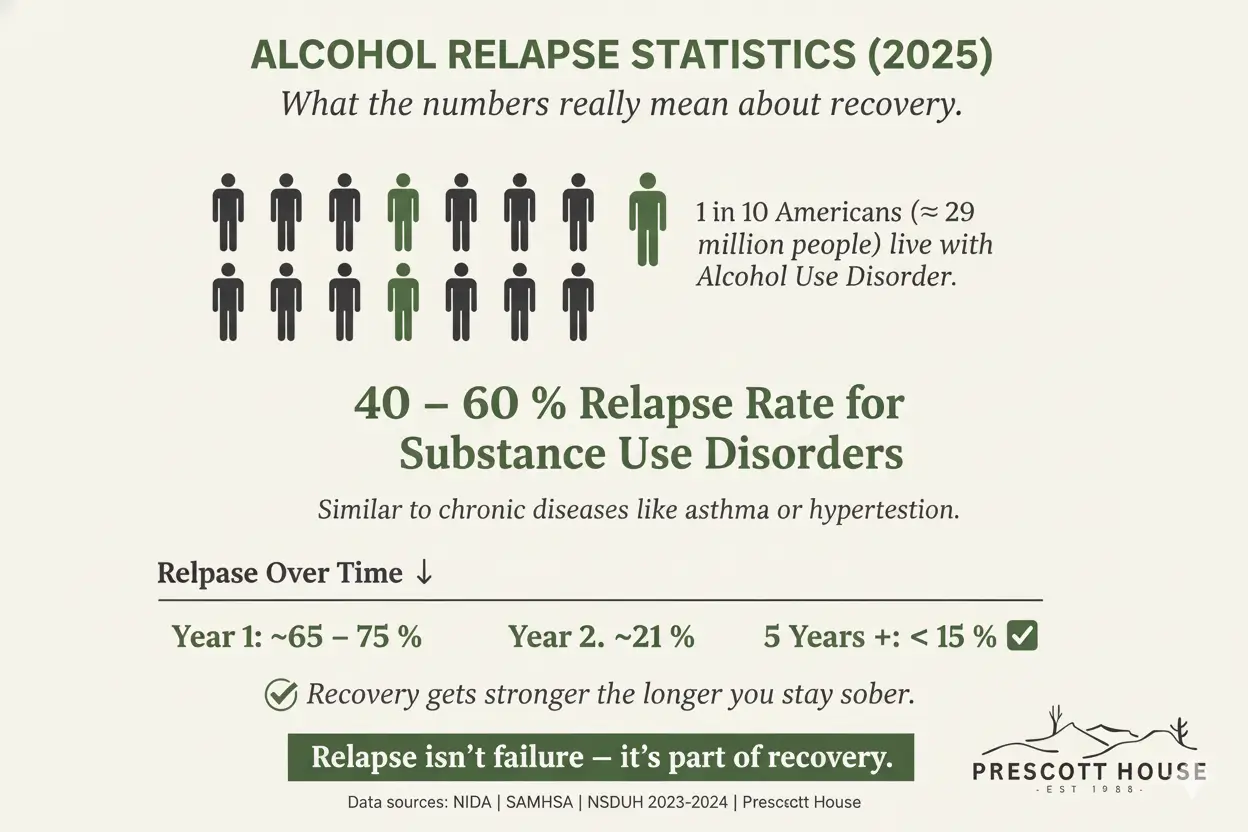In 2023, nearly 29 million Americans aged 12 and older struggled with Alcohol Use Disorder (AUD). That's roughly one in ten people walking past you on the street, sitting in your workplace, or even at your family dinner table. These aren't just statistics—they represent millions of individuals and families grappling with a condition that society still too often misunderstands.
Here's what we need to get straight from the start: relapse is not a moral failing. It's not a sign of weakness, lack of willpower, or poor character. When someone experiences a relapse with alcohol use disorder, they're dealing with a chronic health condition that affects the brain in measurable, physical ways. The relapse rate for substance use disorders sits between 40% and 60%—strikingly similar to other chronic conditions like hypertension and asthma that we never blame patients for experiencing setbacks with.
At Prescott House, we've witnessed countless individuals beat themselves up over a slip or relapse, often more harshly than they would judge a friend facing the same situation. This self-criticism becomes another barrier to recovery rather than a stepping stone toward lasting sobriety.
The landscape of alcohol recovery has shifted dramatically in recent years. We're seeing groundbreaking research in medications, innovative technology solutions, and a deeper understanding of the psychological and social factors that influence long-term success. This isn't your grandfather's approach to addiction treatment—though some of those time-tested principles still hold tremendous value.
This article provides an updated, comprehensive overview of alcohol relapse as we move through 2025. We'll explore current statistics that might surprise you, examine actionable prevention strategies that actually work, and share a hopeful outlook on achieving long-term sobriety in today's complex world.

Understanding Alcohol Relapse: The 2025 Landscape
Before diving into prevention strategies, we need to clarify what we're actually talking about when we say "relapse." The distinction between a slip and a relapse matters more than most people realize—and getting this right can mean the difference between a brief setback and a complete derailment of recovery progress.
The Critical Difference: Slip vs. Relapse
A slip (or lapse) represents a brief return to drinking—maybe a single drink at a wedding or a weekend of old patterns—followed quickly by a recommitment to sobriety. The person recognizes what happened, takes responsibility, and gets back on track without losing sight of their recovery goals.
A relapse, on the other hand, involves a more significant return to old patterns of uncontrolled drinking. It's characterized by abandoning recovery efforts and falling back into the behaviors, mindset, and lifestyle that accompanied active addiction.
Why does this distinction matter so much? Because how someone interprets their experience determines what happens next. When someone views a slip as a complete failure, shame and hopelessness often trigger the very behaviors they're trying to avoid. Understanding that a slip doesn't equal total failure empowers individuals to address the situation quickly before it spirals into something more serious.
The Current Reality: What the Numbers Tell Us
The statistics around alcohol relapse paint a complex picture that's both sobering and encouraging. Roughly two-thirds of individuals treated for AUD may experience a relapse within the first six months of treatment. More than 75% of individuals with alcoholism who receive treatment relapse within the first year.
These numbers might seem discouraging at first glance, but here's the crucial context: the risk of relapse drops dramatically over time. After five years of continuous recovery, the relapse rate falls to below 15%. This isn't just hopeful thinking—it's evidence that sustained recovery becomes increasingly achievable as time passes and coping skills strengthen.
Factors That Influence Relapse Risk in 2025
The modern recovery landscape presents both new challenges and unprecedented opportunities. Social media creates constant exposure to drinking culture, while remote work can increase isolation—two factors that didn't significantly impact recovery even a decade ago. However, we also have better access to support systems, more effective medications, and a growing understanding of personalized treatment approaches.
Individual factors play a massive role in determining relapse risk. Age at first use, family history of addiction, co-occurring mental health conditions, and the presence of strong social support all influence outcomes. Perhaps most importantly, the length and severity of drinking patterns before seeking treatment significantly impacts recovery trajectories.
At Prescott House, we've observed that clients who enter treatment earlier in their drinking careers consistently demonstrate better long-term outcomes. This doesn't mean that individuals with longer histories of alcohol use can't achieve lasting sobriety—it simply means their recovery journey may require different strategies and potentially longer initial treatment periods.
Environmental factors have become increasingly relevant. The normalization of drinking culture in professional settings, the rise of "mommy wine culture," and the bombardment of alcohol advertising through digital platforms all create a more challenging recovery environment than previous generations faced.
The Science Behind Alcohol Relapse: What's Happening in Your Brain
Understanding the neurological basis of relapse helps remove the moral judgment that too often accompanies discussions about returning to drinking. Your brain doesn't care about your willpower or good intentions—it responds to chemical changes, environmental cues, and deeply ingrained neural pathways that develop over years of alcohol use.
The Reward System Hijack
Chronic alcohol use fundamentally alters your brain's reward system. The neurotransmitter dopamine, which should respond to naturally rewarding activities like good food, social connection, or personal achievements, becomes dysregulated. After extended alcohol use, your brain requires increasingly larger amounts of stimulation to experience pleasure or satisfaction.
This neurochemical imbalance explains why early recovery often feels emotionally flat or unrewarding. Activities that once brought joy may feel meaningless. This isn't depression in the traditional sense—it's your reward system recalibrating. The good news? With sustained sobriety, this system can recover, though the timeline varies significantly between individuals.
Memory and Cue Reactivity
Your brain forms powerful associations between environmental cues and alcohol use. The smell of a particular bar, seeing old drinking companions, or even emotional states that previously triggered drinking can activate intense cravings years into recovery. These aren't character flaws—they're conditioned responses that can be measured on brain imaging studies.
Recent research shows that these cue-induced cravings don't necessarily fade with time alone. Instead, they require active intervention through exposure therapy, mindfulness practices, or medications that can help reduce their intensity. Understanding this helps explain why "white-knuckling" through cravings often proves ineffective long-term.
Stress Response and Executive Function
Chronic alcohol use impairs the prefrontal cortex—the brain region responsible for decision-making, impulse control, and long-term planning. Simultaneously, it heightens reactivity in the limbic system, which processes emotions and stress responses. This creates a perfect storm where you experience intense emotional reactions but have reduced capacity to manage them effectively.
This neurological imbalance explains why stress represents such a significant relapse trigger. When faced with challenging situations, your brain defaults to previously learned coping mechanisms (drinking) rather than newly developed strategies. Recognizing this pattern allows for proactive planning rather than reactive scrambling when stressful situations arise.

Early Warning Signs: Recognizing Relapse Before It Happens
Relapse rarely happens suddenly. It typically unfolds as a process with recognizable stages, each offering opportunities for intervention. Learning to identify these warning signs—both in yourself and loved ones—can prevent a temporary struggle from becoming a full-blown return to active addiction.
Emotional Relapse: The First Stage
Emotional relapse begins long before someone picks up a drink. During this stage, you're not actively thinking about drinking, but your emotional and behavioral patterns start setting up the conditions that make relapse more likely. You might notice increased irritability, social isolation, or neglect of self-care routines.
Sleep patterns often deteriorate first. You might start staying up later, sleeping irregularly, or experiencing insomnia. Appetite changes are common, as is decreased attention to personal hygiene or living space maintenance. These might seem like minor issues, but they represent early warning signs that shouldn't be ignored.
Meeting attendance drops off—whether that's AA meetings, therapy sessions, or other recovery activities. You might rationalize this as being "too busy" or feeling like you "don't need them anymore," but these are classic signs that your recovery foundation is beginning to weaken.
Mental Relapse: The Internal Battle
Mental relapse represents the stage where part of your mind starts entertaining thoughts about drinking while another part fights against these ideas. This internal conflict creates significant emotional stress and often manifests as increased anxiety, mood swings, or difficulty concentrating.
You might find yourself romanticizing past drinking experiences, conveniently forgetting the negative consequences while focusing on the perceived positive aspects. Thoughts like "I could probably handle just one drink now" or "Maybe I wasn't as bad as I thought" become more frequent and persistent.
Planning behaviors often emerge during this stage. You might research old drinking establishments, reconnect with drinking companions, or put yourself in situations where alcohol is readily available—all while maintaining that you don't intend to drink.
At Prescott House, we teach clients that experiencing these thoughts doesn't mean relapse is inevitable. The key lies in recognizing them as warning signs rather than facts or commands that must be acted upon. This awareness creates space for intervention before thoughts translate into actions.
Your Recovery Journey: Moving Forward with Knowledge and Hope
Recovery from alcohol use disorder isn't a straight line—it's a winding path that includes setbacks, breakthroughs, learning experiences, and continuous growth. The most important message we want you to take from this article is that relapse doesn't mean failure, and understanding the science behind these experiences can transform how you approach your recovery journey.
The statistics we've explored aren't meant to discourage you but to provide realistic expectations and remove the shame that so often accompanies struggles with alcohol. When you understand that relapse rates decrease dramatically over time, that your brain is actively healing throughout recovery, and that warning signs can be recognized and addressed before they escalate, you're equipped with powerful tools for long-term success.
The recovery landscape in 2025 offers unprecedented hope. We have better medications, more effective therapeutic approaches, and a growing understanding that addiction treatment must be personalized to each individual's unique circumstances. The stigma surrounding alcohol use disorder continues to fade as more people recognize it as the chronic health condition it truly is.
Perhaps most importantly, remember that seeking help isn't a sign of weakness—it's an act of courage and self-advocacy. Whether you're in early recovery, returning after a relapse, or supporting a loved one through their journey, professional support can make all the difference in achieving lasting sobriety.
If you recognize yourself in any of the patterns described in this article, or if you're struggling with alcohol use disorder, know that help is available. At Prescott House, our experienced team understands the complexities of addiction and recovery. We provide evidence-based treatment approaches tailored to each individual's needs, because we believe that everyone deserves a chance at lasting recovery.
Your story isn't over—it's still being written. Each day of recovery, each moment of choosing health over addiction, each decision to reach out for support contributes to a narrative of resilience, growth, and hope. The path forward may not always be easy, but with the right support, tools, and understanding, it's absolutely possible.
Take the first step today. Whether that's calling a treatment center, attending a support group meeting, or simply having an honest conversation with someone you trust about your concerns with alcohol, every journey toward recovery begins with a single, courageous decision to seek something better.













